- Ask a related questionWhat is a related question?A related question is a question created from another question. When the related question is created, it will be automatically linked to the original question.
This thread has been locked.
If you have a related question, please click the "Ask a related question" button in the top right corner. The newly created question will be automatically linked to this question.
Tool/software:
hello,
Our current application is to synchronize all the input and output clocks of the LMK04828, and the phases are aligned after the sync signal is controlled;
Now there are 3 questions : 1. The input and output are not synchronized, and the phase difference is also not fixed (it will change after each power-on restart). 2. After the sync signal is controlled, the waveform can be seen to flicker on the oscilloscope, but there is no change. 3. Is there a timing requirement when configuring registers for SPI?
【Current configuration】
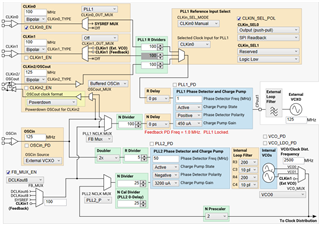
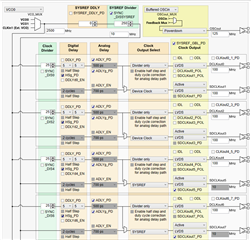
Hi Fan,
The AE is OoO -
Give us until end of week - sorry about delay.
Best regards,
Vicente
Hi Fan,
I suspect that you may be using nested zero-delay dual-loop mode, when you should be using cascaded zero-delay dual-loop mode. You can select dual loop 0-delay cascaded mode in the Set Modes menu in TICS Pro. However, I put together a config that may be what you need. I would prefer if you could send over your configuration, so that I can be 100% positive it is what you need, but this should be enough to make sure you have a deterministic relationship between the reference and output phase.
Thanks,
Michael
Hello Michael,
Thank you for your reply. The current configuration is configured LMK04828 to Nested Zero-Delay Dual-Loop Mode. All outputs are configured as Device Clock Output (CLKIN0 = 100MHZ; VCXO = 125MHz; CLKOUT = 100MHz) ; I want to use the SYNC input(SYNC pin, without using the sysref function) to trigger the synchronization of all output clocks.
R0 (INIT) 0x000090 R0 0x000010 R2 0x000200 R3 0x000306 R4 0x0004D0 R5 0x00055B R6 0x000600 R12 0x000C51 R13 0x000D04 R256 0x010019 R257 0x010155 R258 0x010255 R259 0x010300 R260 0x010400 R261 0x010500 R262 0x010670 R263 0x010711 R264 0x010819 R265 0x010955 R266 0x010A55 R267 0x010B00 R268 0x010C00 R269 0x010D00 R270 0x010E70 R271 0x010F11 R272 0x011019 R273 0x011155 R274 0x011255 R275 0x011300 R276 0x011400 R277 0x011500 R278 0x011670 R279 0x011711 R280 0x011819 R281 0x011955 R282 0x011A55 R283 0x011B00 R284 0x011C00 R285 0x011D00 R286 0x011E70 R287 0x011F11 R288 0x012019 R289 0x012155 R290 0x012255 R291 0x012300 R292 0x012400 R293 0x012500 R294 0x012670 R295 0x012711 R296 0x012819 R297 0x012955 R298 0x012A55 R299 0x012B00 R300 0x012C00 R301 0x012D00 R302 0x012E70 R303 0x012F11 R304 0x013019 R305 0x013155 R306 0x013255 R307 0x013300 R308 0x013400 R309 0x013500 R310 0x013670 R311 0x013711 R312 0x013800 R313 0x013900 R314 0x013A00 R315 0x013BFA R316 0x013C00 R317 0x013D00 R318 0x013E00 R319 0x013F0B R320 0x014009 R321 0x014100 R322 0x014200 R323 0x014351 R324 0x014400 R325 0x01457F R326 0x014608 R327 0x01470E R328 0x014833 R329 0x014945 R330 0x014A05 R331 0x014B16 R332 0x014C00 R333 0x014D00 R334 0x014EC0 R335 0x014F7F R336 0x015003 R337 0x015102 R338 0x015200 R339 0x015300 R340 0x01540A R341 0x015500 R342 0x01560A R343 0x015700 R344 0x01580A R345 0x015900 R346 0x015A0A R347 0x015BD4 R348 0x015C20 R349 0x015D00 R350 0x015E00 R351 0x015F0B R352 0x016000 R353 0x016105 R354 0x016245 R355 0x016300 R356 0x016400 R357 0x016519 R369 0x0171AA R370 0x017202 R380 0x017C15 R381 0x017D33 R358 0x016600 R359 0x016700 R360 0x016819 R361 0x016959 R362 0x016A20 R363 0x016B00 R364 0x016C00 R365 0x016D00 R366 0x016E1B R371 0x017300 R386 0x018200 R387 0x018300 R388 0x018400 R389 0x018500 R392 0x018800 R393 0x018900 R394 0x018A00 R395 0x018B00 R8189 0x1FFD00 R8190 0x1FFE00 R8191 0x1FFF53

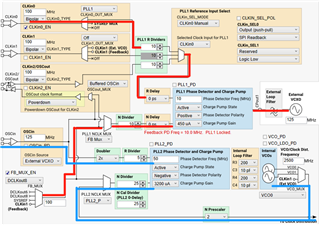
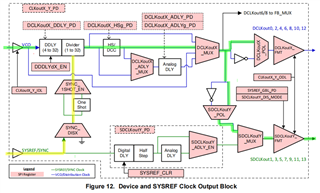
BR//Fan
Hi Fan,
I have reconstructed your setup and tested it in lab. I have had no issues with synchronization, and I think that yours are the result of not synchronizing your dividers. What do you mean when you say you are controlling the SYNC signal? You can synchronize your dividers by pressing the "SYNC Dividers" button in the SYNC/SYSREF tab. Please let me know if you have anymore questions.
Thanks,
Michael
Hello Michael,
Can you show your oscilloscope test waveform?
In my tests, I wanted to use the sync pin inversion to control the synchronization process, and the manual supports connecting external signals via sync pin, or SPI. This test way is my final application.
There are three problems in my lab bench:
1. The waveform between the output channels cannot be aligned, and there is a little deviation;
2. The input(CLKin0) and the output(DCLKoutX) cannot be aligned, that is to say, it is not 0-delay;
3. After power cycle, these waveforms will be phased shifted.This results in inconsistent results every time.
The blue is the input(CLKin0), and the red and green ones are the two channels(DCLKoutX) of the outputs:
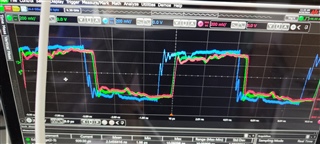
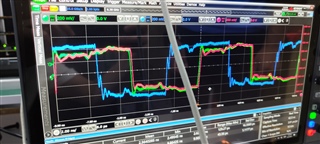
BR//Fan
Hi Fan,
Sorry for the delay. I had to perform a rework to board in order to allow for the VCXO to be input as 125 MHz. I will get to you tomorrow.
Thanks,
Michael
Hi Fan,
The scope shot that I took can be seen below. The yellow sinusoidal signal is the CLKIN0 input signal and the other two are DCLKoutx outputs (blue is 10, orange is 0, respectively). There will be some skew and delays that are the result of wiring and traces that cannot be removed. 0-delay is actually a bit of a misnomer; 0-delay mode actually means that the delay between the input and feedback output (and any outputs synced to that feedback output, which can be selected in the SYNC/SYSREF page by clicking the appropriate SYNC_DISx boxes) will be deterministic. You need to ensure that you are syncing your dividers upon each power cycle to make sure your outputs are phase-aligned.
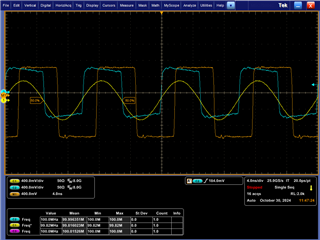
I have attached my config file (which is for a LMK04826, which is very similar to the LMK04828 but needs to be translated to a config for a 4828) for more clarification. Furthermore, I would like to see your schematic/setup. Are you using an EVM board? If so, have you reworked the board so that your external VCXO is 125 MHz?
Thanks,
Michael
Hello Michael,
There are a few more points that I need to confirm from your:
1, Is the input signal generated with a signal generator? or by XO?
2, the waveform is seems not quite right, the oscilloscope's C3 does not show, the M1(orange ) in the graph should be the result of the math function, right?
3, the amplitude of the two DCLKoutx in the waveform is not consistent, the relative difference is nearly 1.5ns. The difference in the output result between the two channels is too big.
4, the EVM can be through the TICS pro to control the sync function, but for the formal application, how do we control it, according to the TICS pro export file can be executed or need to add the sync step in the end?
5,For the power cycle, we fixed the SPI control program into the FPGA to control the LMK04828, and then the whole system together to carry out the power cycle operation. The phase change between the two output channels occurs at the fifteenth.You can help with the experiments on your end, too.
We haven't applied for our EVM yet, some of our current experiments are referencing the EVM to make our own boards, I'll send it to you privately and you help to review the schematic, thanks a lot!
BR//Fan
Hi Fan,
1. The input signal is generated by an SMA100 signal generator.
2. M1 is a math signal - it is C3 - C4, where C3 is the non-inverted output from DCLKout0 and C4 is the inverted output from DCLKout0.
3. The difference in amplitude is due to the way I fed the signals into the oscilloscope. C2 was measured by taking the two outputs from DCLKout10 and sending them through a balun, whereas M1 was measured by inputting each differential signal to the oscilloscope and relying on the math function to resolve the signal. I will see if I can find an additional balun, so that the amplitudes will be the same, and I can send an additional scope shot. The skew is also a bit larger than it should be, I can resolve that too.
4. The SYNC function can be controlled through various methods (see section 9.7.3.10 in the LMK04828 datasheet), but the easiest method would be to set SYNC_MODE to 1 and input a rising edge to the SYNC pin. That rising edge serves as the "SYNC event" which will synchronize all of the selected output dividers (selected by the SYNC_DISx bit, where x corresponds to the CLKoutx channel, which will be synchronized upon the SYNC event so long as SYNC_DISx is set to 1).
5. I am a bit confused by what you mean here. The phase change between the two output channels occurs at the fifteenth occurrence of what? Have you tried synching the dividers when that happens?
Also, you are more than welcome to send any questions or schematics to my email, m-srinivasan@ti.com :)
Thanks,
Michael
Hello Michael,
Thank you for getting back to me. I'm going to continue tracking our issue with email.
BR//Fan